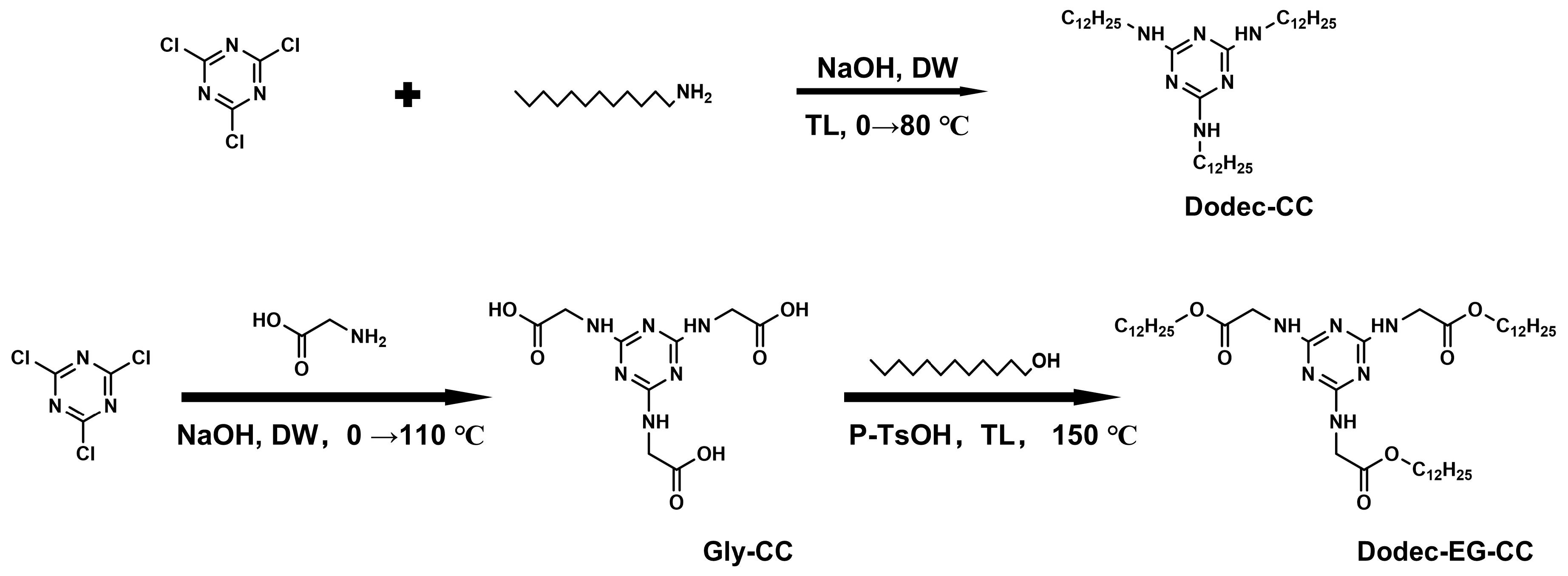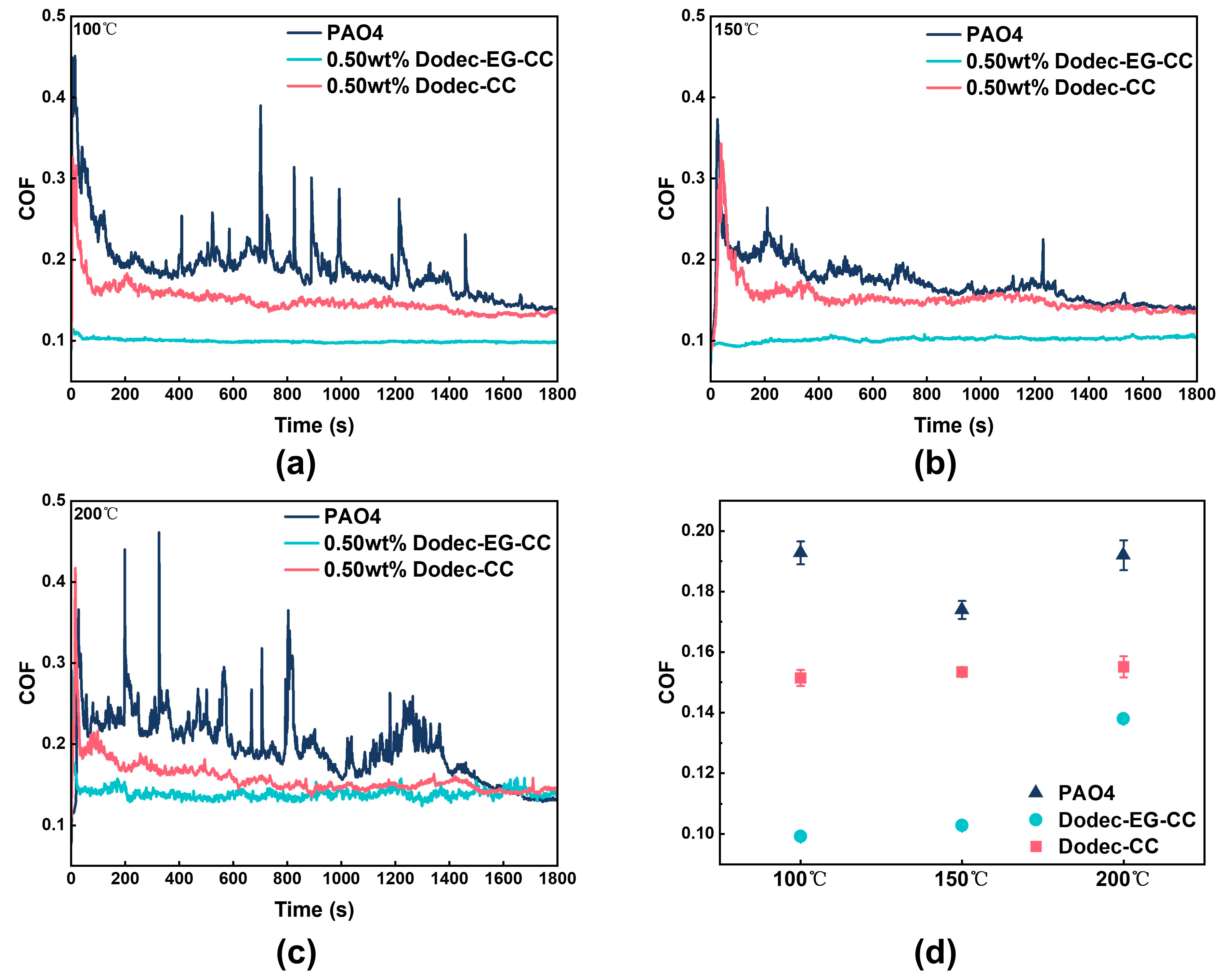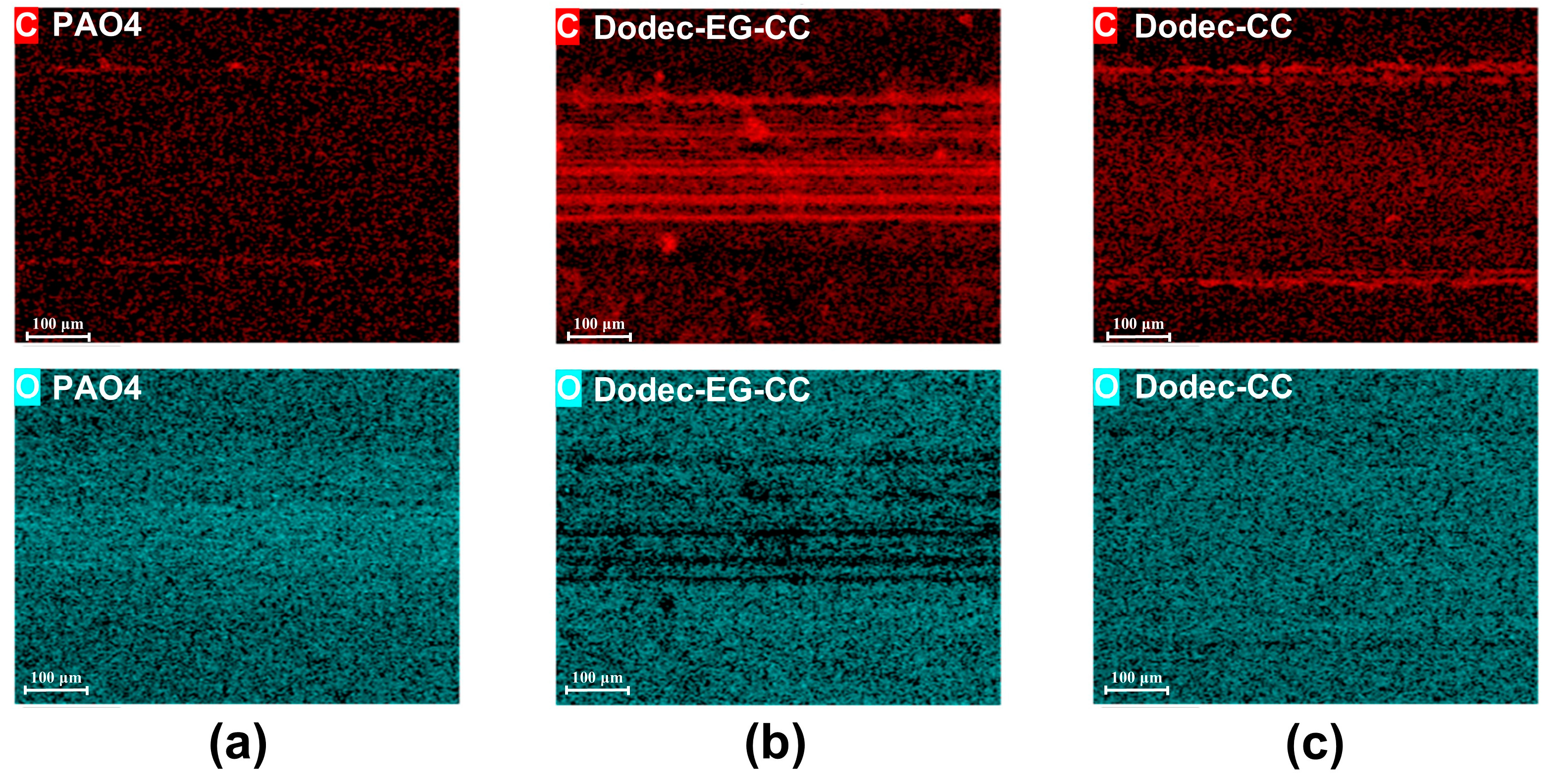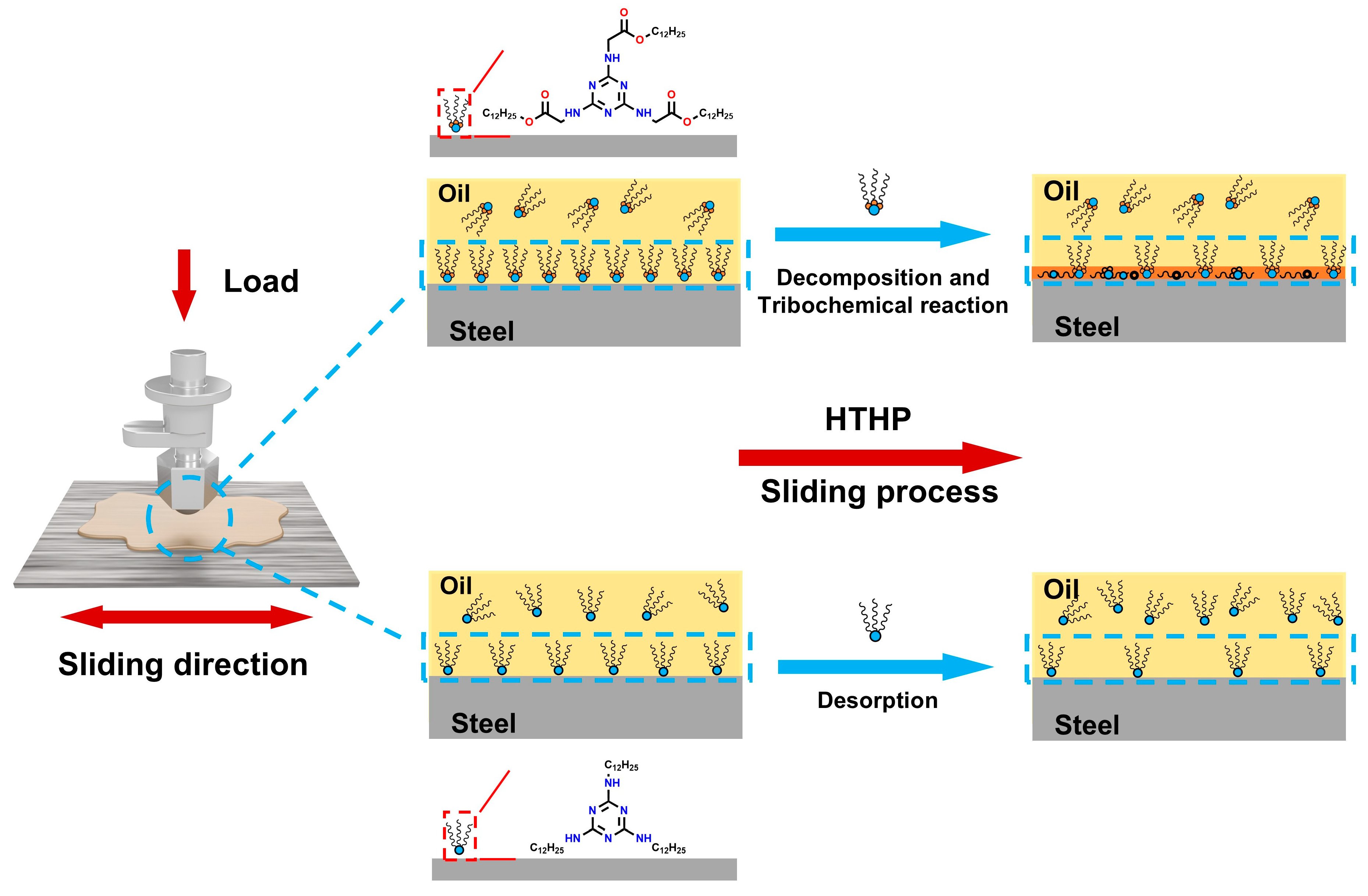Enhanced Tribological Performance of Melamine Long-Chain Alcohol Esters in High-Temperature Boundary Lubrication
Abstract
1. Introduction
2. Experimental Section
2.1. Materials
2.2. Synthesis
2.2.1. Synthesis of Dodec-CC
2.2.2. Synthesis of Gly-CC
2.2.3. Synthesis of Dodec-EG-CC
2.3. Tribological Tests
2.4. Simulation Method and Conditions
2.5. Characterization
3. Results and Discussion
3.1. Characterization of the Synthesized Triazine Derivatives
3.2. Analysis of Thermal Stability
3.3. Analysis of Adsorption Behavior
3.4. Tribological Properties Analysis
3.5. Analysis of Wear Surfaces
3.6. Mechanism Hypothesis
4. Conclusions
- Two triazine derivatives were synthesized using a simple and efficient synthetic method, and their structures were confirmed by NMR, IR, and MS characterization techniques. Thermogravimetric analysis indicated that the synthesized compounds exhibit excellent thermal stability, with initial decomposition temperatures exceeding 310 °C. Such outstanding thermal stability is a key performance characteristic of high-temperature lubricant additives.
- Adsorption behavior analysis showed that both triazine derivatives could effectively adsorb onto metal surfaces. Further analysis revealed that Dodec-EG-CC exhibited superior adsorption on metal substrates compared to Dodec-CC. The difference in adsorption behavior is likely a key factor contributing to the variation in tribological performance.
- Tribological test results demonstrated that both additive molecules significantly improved the friction-reducing performance of base oil PAO4 over a wide temperature range of 100–200 °C. Notably, Dodec-EG-CC achieved a 28% reduction in the average friction coefficient even at 200 °C. The friction-reducing and anti-wear performance of Dodec-EG-CC was comprehensively superior to that of Dodec-CC, indicating that the incorporation of ester groups into the alkyl chain effectively enhances the tribological properties of the additive molecules.
- Friction surface analysis revealed that additive molecules form an adsorption film on the metal surface, effectively preventing direct contact between the friction pairs. During the friction process, harsh environmental factors such as high temperature and pressure promote the desorption, decomposition, and further tribochemical reactions of the additive molecules, leading to the formation of carbon-based materials. Dodec-EG-CC, with its excellent adsorption performance on the metal surface, adheres firmly and is more likely than Dodec-CC to generate carbon-based materials. This process forms a protective friction film that prevents direct contact between the friction pairs and inhibits the formation of metal oxides.
- This study provides a feasible solution for equipment lubrication under harsh working conditions, especially in high-temperature environments. It enhances the stability and service life of machinery by effectively reducing wear and preventing surface degradation. Furthermore, this research offers new theoretical insights into the structure design and development of environmentally friendly additives. By highlighting the role of functional groups, such as the ester moiety, in enhancing lubrication performance, this work contributes to the advancement of green innovation in the lubricants field. Future work will focus on further optimizing the molecular structure of these additives to improve their thermal stability and film-forming capabilities.
Supplementary Materials
Author Contributions
Funding
Data Availability Statement
Conflicts of Interest
References
- Tung, S.C.; McMillan, M.L. Automotive tribology overview of current advances and challenges for the future. Tribol. Int. 2004, 37, 517–536. [Google Scholar] [CrossRef]
- Ji, H.; Zhang, X.; Tan, T. Preparation of a Water-Based Lubricant from Lignocellulosic Biomass and Its Tribological Properties. Ind. Eng. Chem. Res. 2017, 56, 7858–7864. [Google Scholar] [CrossRef]
- Wang, H.; Wang, Y.; Wen, P.; Ma, L.; Fan, M.; Dong, R.; Zhang, C. Low-viscosity oligoether esters (OEEs) as high-efficiency lubricating oils: Insight on their structure–lubricity relationship. Friction 2023, 12, 1133–1153. [Google Scholar] [CrossRef]
- Zachariah, Z.; Nalam, P.C.; Ravindra, A.; Raju, A.; Mohanlal, A.; Wang, K.; Castillo, R.V.; Espinosa-Marzal, R.M. Correlation Between the Adsorption and the Nanotribological Performance of Fatty Acid-Based Organic Friction Modifiers on Stainless Steel. Tribol. Lett. 2019, 68, 11. [Google Scholar] [CrossRef]
- Hu, M.; Ma, R.; Zhang, S.; Han, Y.; Zhao, J.; Zhang, M.; Li, W.; Liu, H. Preparation and tribological study of novel amide-based organic friction modifiers. Tribol. Int. 2024, 194, 109465. [Google Scholar] [CrossRef]
- Cyriac, F.; Tee, X.Y.; Poornachary, S.K.; Chow, P.S. Influence of structural factors on the tribological performance of organic friction modifiers. Friction 2020, 9, 380–400. [Google Scholar] [CrossRef]
- Xu, X.; Yang, F.; Yang, H.; Zhao, Y.; Sun, X.; Tang, Y. Preparation and Tribological Behaviors of Sulfur- and Phosphorus-Free Organic Friction Modifier of Amide–Ester Type. Lubricants 2024, 12, 196. [Google Scholar] [CrossRef]
- Song, W.; Campen, S.; Shiel, H.; Gattinoni, C.; Zhang, J.; Wong, J.S.S. Position of Carbonyl Group Affects Tribological Performance of Ester Friction Modifiers. ACS Appl. Mater. Interfaces 2024, 16, 14252–14262. [Google Scholar] [CrossRef]
- Eickworth, J.; Wagner, J.; Daum, P.; Dienwiebel, M.; Rühle, T. Gas phase lubrication study with an organic friction modifier. Lubr. Sci. 2022, 35, 40–55. [Google Scholar] [CrossRef]
- Vaitkunaite, G.; Espejo, C.; Thiebaut, B.; Neville, A.; Morina, A. Low friction tribofilm formation and distribution on an engine cylinder tested with MoDTC-containing low viscosity engine lubricants. Tribol. Int. 2022, 171, 107551. [Google Scholar] [CrossRef]
- Davidson, J.E.; Hinchley, S.L.; Harris, S.G.; Parkin, A.; Parsons, S.; Tasker, P.A. Molecular dynamics simulations to aid the rational design of organic friction modifiers. J. Mol. Graph. Model. 2006, 25, 495–506. [Google Scholar] [CrossRef]
- Wei, P.; Gao, P.; Pu, W. Nonequilibrium molecular dynamics investigation on friction behavior of organic friction modifiers under dynamic load. J. Mol. Liq. 2024, 407, 125195. [Google Scholar] [CrossRef]
- Gu, H.; Hirayama, T.; Yamashita, N.; Xu, J.; Yamada, M. Relationship between friction reduction effect and solubility in base oil of organic friction modifiers. Tribol. Int. 2025, 202, 110304. [Google Scholar] [CrossRef]
- Fry, B.M.; Moody, G.; Spikes, H.A.; Wong, J.S.S. Adsorption of Organic Friction Modifier Additives. Langmuir 2020, 36, 1147–1155. [Google Scholar] [CrossRef] [PubMed]
- Cyriac, F.; Yamashita, N.; Hirayama, T.; Yi, T.X.; Poornachary, S.K.; Chow, P.S. Mechanistic insights into the effect of structural factors on film formation and tribological performance of organic friction modifiers. Tribol. Int. 2021, 164, 107243. [Google Scholar] [CrossRef]
- Meng, Y.; Wen, X.; Cheng, J.; Bai, P.; Meng, Y.; Tian, Y. High temperature lubrication performance of chlorophenyl silicone oil. Friction 2024, 12, 1716–1727. [Google Scholar] [CrossRef]
- Meng, Y.; Xu, J.; Jin, Z.; Prakash, B.; Hu, Y. A review of recent advances in tribology. Friction 2020, 8, 221–300. [Google Scholar] [CrossRef]
- Wang, W.; Shen, B.; Li, Y.; Ni, Q.; Zhou, L.; Du, F. Friction reduction mechanism of glycerol monooleate-containing lubricants at elevated temperature—Transition from physisorption to chemisorption. Sci. Prog. 2021, 104, 36850421998529. [Google Scholar] [CrossRef]
- Chen, Q.; Zhang, R.; He, Z.; Xiong, L. Tribological performance of N-containing heterocyclic triazine derivative as lubricant additive in ethylene glycol. Surf. Interface Anal. 2021, 53, 1027–1034. [Google Scholar] [CrossRef]
- Desanker, M.; He, X.; Lu, J.; Johnson, B.A.; Liu, Z.; Delferro, M.; Ren, N.; Lockwood, F.E.; Greco, A.; Erdemir, A.; et al. High-Performance Heterocyclic Friction Modifiers for Boundary Lubrication. Tribol. Lett. 2018, 66, 50. [Google Scholar] [CrossRef]
- Mao, S.; Wang, B.; Dai, S.; Lu, H. Synthesizing Benzotriazole Group-Terminated Carbon Dots as Multifunctional Additives of Poly(ethylene glycol). Langmuir 2024, 40, 1922–1930. [Google Scholar] [CrossRef] [PubMed]
- Desanker, M.; He, X.; Lu, J.; Liu, P.; Pickens, D.B.; Delferro, M.; Marks, T.J.; Chung, Y.-W.; Wang, Q.J. Alkyl-Cyclens as Effective Sulfur- and Phosphorus-Free Friction Modifiers for Boundary Lubrication. ACS Appl. Mater. Interfaces 2017, 9, 9118–9125. [Google Scholar] [CrossRef]
- Wu, Y.; He, Z.; Zeng, X.; Ren, T.; de Vries, E.; van der Heide, E. Tribological and anticorrosion behaviour of novel xanthate-containing triazine derivatives in water-glycol. Tribol. Int. 2017, 110, 113–124. [Google Scholar] [CrossRef]
- Zeng, X.; Wu, H.; Yi, H.; Ren, T. Tribological behavior of three novel triazine derivatives as additives in rapeseed oil. Wear 2007, 262, 718–726. [Google Scholar] [CrossRef]
- Capel Berdiell, I.; Farmiloe, S.E.; Kulmaczewski, R.; Halcrow, M.A. Molecular squares, coordination polymers and mononuclear complexes supported by 2,4-dipyrazolyl-6H-1,3,5-triazine and 4,6-dipyrazolylpyrimidine ligands. Dalton Trans. 2019, 48, 17310–17320. [Google Scholar] [CrossRef]
- Jin, Y.; Li, J.; Jia, D.; Tu, J.; Zhan, S.; Yang, T.; Duan, H. Online infrared spectra analysis of multi-phenol antioxidants in ester lubricant during friction under high-temperature oxidation. Tribol. Int. 2022, 176, 107877. [Google Scholar] [CrossRef]
- Hu, W.; Zhang, Z.; Zeng, X.; Li, J. Correlation between the Degree of Alkylation and Tribological Properties of Amino-PEG2-amine-Based Organic Friction Modifiers. Ind. Eng. Chem. Res. 2019, 59, 215–225. [Google Scholar] [CrossRef]
- Lee, C.T.; Lee, M.B.; Hamdan, S.H.; Chong, W.W.F.; Chong, C.T.; Zhang, H.; Chen, A.W.L. Trimethylolpropane trioleate as eco-friendly lubricant additive. Eng. Sci. Technol. Int. J. 2022, 35, 101068. [Google Scholar] [CrossRef]
- Hu, W.; Xu, Y.; Zeng, X.; Li, J. Alkyl-Ethylene Amines as Effective Organic Friction Modifiers for the Boundary Lubrication Regime. Langmuir 2020, 36, 6716–6727. [Google Scholar] [CrossRef]
- Zhou, F.; Chen, K.; Wang, M.; Xu, X.; Meng, H.; Yu, M.; Dai, Z. Friction and wear properties of CrN coatings sliding against Si3N4 balls in water and air. Wear 2008, 265, 1029–1037. [Google Scholar] [CrossRef]
- Thompson, A.P.; Aktulga, H.M.; Berger, R.; Bolintineanu, D.S.; Brown, W.M.; Crozier, P.S.; in’t Veld, P.J.; Kohlmeyer, A.; Moore, S.G.; Nguyen, T.D.; et al. LAMMPS—A flexible simulation tool for particle-based materials modeling at the atomic, meso, and continuum scales. Comput. Phys. Commun. 2022, 271, 108171. [Google Scholar] [CrossRef]
- Knothe, G.; Steidley, K.R. Lubricity of Components of Biodiesel and Petrodiesel. The Origin of Biodiesel Lubricity. Energy Fuels 2005, 19, 1192–1200. [Google Scholar] [CrossRef]
- Boiko, M.V.; Sidashov, A.V.; Boiko, T.G.; Burykin, I.V.; Uflyand, I.E. The mechanism of formation of boundary lubricating films during friction in a medium of di(2-ethylhexyl) sebacate. Tribol. Int. 2022, 165, 107222. [Google Scholar] [CrossRef]
- Yu, H.; Chen, H.; Zheng, Z.; Ba, Z.; Qiao, D.; Feng, D.; Gong, Z.; Dong, G. Transformation mechanism between the frictional interface under dioctyl sebacate lubrication. Tribol. Int. 2021, 155, 106745. [Google Scholar] [CrossRef]
- Qiu, F.; Feng, W.; Song, H.; Yang, Z.; Zhang, F.; Hu, X. On the Structure–Activity Relationship of Glyceryl oleate Friction Modifiers and Its Synergistic Mechanism on Phosphate ester Antiwear Additives. Tribol. Lett. 2023, 71, 90. [Google Scholar] [CrossRef]
- Saini, V.; Seth, S.; Ramakumar, S.S.V.; Bijwe, J. Carbon Nanoparticles of Varying Shapes as Additives in Mineral Oil Assessment of Comparative Performance Potential. ACS Appl. Mater. Interfaces 2021, 13, 38844–38856. [Google Scholar] [CrossRef]
- Liu, K.; Ren, E.; Ma, J.; Cao, Y.; Du, J.; Ming, W.; Li, X.; Li, B. Controllable preparation of graphene-based film deposited on cemented carbides by chemical vapor deposition. J. Mater. Sci. 2019, 55, 4251–4264. [Google Scholar] [CrossRef]
- Johnson, B.; Wu, H.; Desanker, M.; Pickens, D.; Chung, Y.-W.; Jane Wang, Q. Direct Formation of Lubricious and Wear-Protective Carbon Films from Phosphorus- and Sulfur-Free Oil-Soluble Additives. Tribol. Lett. 2017, 66, 2. [Google Scholar] [CrossRef]
- Wu, H.; Khan, A.M.; Johnson, B.; Sasikumar, K.; Chung, Y.-W.; Wang, Q.J. Formation and Nature of Carbon-Containing Tribofilms. ACS Appl. Mater. Interfaces 2019, 11, 16139–16146. [Google Scholar] [CrossRef]
- Erdemir, A.; Ramirez, G.; Eryilmaz, O.L.; Narayanan, B.; Liao, Y.; Kamath, G.; Sankaranarayanan, S.K.R.S. Carbon-based tribofilms from lubricating oils. Nature 2016, 536, 67–71. [Google Scholar] [CrossRef]
- Niu, Y.; Pang, X.; Yue, S.; Shangguan, B.; Zhang, Y. The friction and wear behavior of laser textured surfaces in non-conformal contact under starved lubrication. Wear 2021, 476, 203723. [Google Scholar] [CrossRef]
- Sukjit, E.; Poapongsakorn, P.; Dearn, K.D.; Lapuerta, M.; Sánchez-Valdepeñas, J. Investigation of the lubrication properties and tribological mechanisms of oxygenated compounds. Wear 2017, 376–377, 836–842. [Google Scholar] [CrossRef]












| Functional Group | Dodec-EG-CC (cm−1) | Dodec-CC (cm−1) |
|---|---|---|
| -NH | 3341.85 | 3349.38 |
| -CH3, -CH2 | 2916.03, 2849.78 | 2915.34, 2848.09 |
| C=O (ester group) | 1746.61, 1721.53 | None |
| N-H | 1590.63 | 1623.80 |
| C=N (triazine ring) | 1533.13, 1499.03 | 1530.31 |
| -CH2, -CH3 | 1470.60, 1372.37 | 1468.25, 1362.95 |
| C-O (ester group), O-C=O | 1230.10, 1187.13 | None |
| triazine ring | 807.68 | 808.22 |
| (CH2)n | 720.08 | 720.04 |
(μm3/(N·mm) | Sa (nm) | Sv (μm) | Sz (μm) | Ssk | |
|---|---|---|---|---|---|
| Dodec-EG-CC | 4.93 × 104 | 850 | −3.185 | 5.376 | −0.787 |
| Dodec-CC | 5.94 × 105 | 2886 | −8.243 | 14.948 | −0.002 |
| PAO4 | 7.03 × 105 | 3282 | −6.698 | 14.816 | 0.262 |
Disclaimer/Publisher’s Note: The statements, opinions and data contained in all publications are solely those of the individual author(s) and contributor(s) and not of MDPI and/or the editor(s). MDPI and/or the editor(s) disclaim responsibility for any injury to people or property resulting from any ideas, methods, instructions or products referred to in the content. |
© 2025 by the authors. Licensee MDPI, Basel, Switzerland. This article is an open access article distributed under the terms and conditions of the Creative Commons Attribution (CC BY) license (https://creativecommons.org/licenses/by/4.0/).
Share and Cite
Zhang, J.; Hu, W.; Li, J. Enhanced Tribological Performance of Melamine Long-Chain Alcohol Esters in High-Temperature Boundary Lubrication. Lubricants 2025, 13, 114. https://doi.org/10.3390/lubricants13030114
Zhang J, Hu W, Li J. Enhanced Tribological Performance of Melamine Long-Chain Alcohol Esters in High-Temperature Boundary Lubrication. Lubricants. 2025; 13(3):114. https://doi.org/10.3390/lubricants13030114
Chicago/Turabian StyleZhang, Jingchun, Wenjing Hu, and Jiusheng Li. 2025. "Enhanced Tribological Performance of Melamine Long-Chain Alcohol Esters in High-Temperature Boundary Lubrication" Lubricants 13, no. 3: 114. https://doi.org/10.3390/lubricants13030114
APA StyleZhang, J., Hu, W., & Li, J. (2025). Enhanced Tribological Performance of Melamine Long-Chain Alcohol Esters in High-Temperature Boundary Lubrication. Lubricants, 13(3), 114. https://doi.org/10.3390/lubricants13030114






